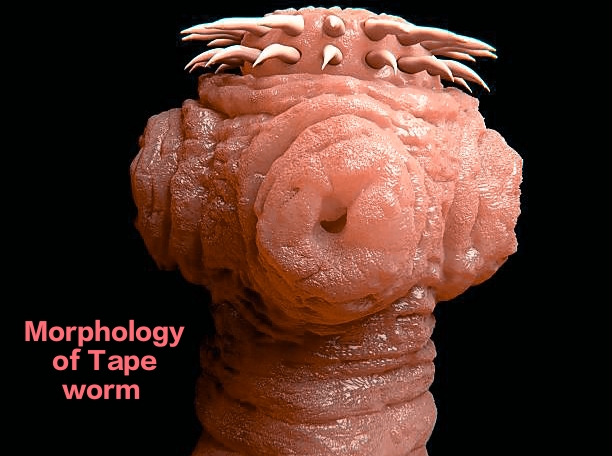Tapeworm infection
If you ingest certain flatworm eggs, they'll migrate outside your intestines and form larval cysts in body tissues and organs (invasive infection). If you ingest flatworm larvae, however, they become adult tapeworms in your intestines (an intestinal infection). Like tapeworms, pinworm infection, and Ascaris lumbricoides are highly contagious, the pinworm is also an intestinal parasite that lay thousands of eggs in the intestine and spread disease.
An adult flatworm consists of a head, a neck, and a chain of segments referred to as proglottids. After you have an enteric infection, the flatworm head adheres to the intestinal wall, and the proglottids grow and manufacture eggs. Intestinal flatworm infections are typically delicate, with only 1 or 2 adult tapeworms. However, invasive larval infections will cause serious complications.
Symptoms
Many people with enteric infections don't have symptoms. If you have issues from the infection, your symptoms can depend on the type of flatworm you've got and its location. Invasive infection symptoms vary depending on where the larvae have migrated.
Intestinal infection
Signs and symptoms of enteric infection include:
• Nausea
• Weakness
• Loss of appetite
• Abdominal pain
• Diarrhoea
• Dizziness
• Salt desire
Invasive infection
If flatworm larvae have migrated out of your intestines and formed cysts in alternative tissues, they'll eventually cause organ and tissue harm, resulting in:
• Headaches
• Cystic lots or lumps
• Allergic reactions to the larvae
• Neurological signs and symptoms, together with seizures
When to envision a doctor?
If you have expertise in any of the signs or symptoms of infection, look for medical attention.
Causes
An infection starts with the activity of flatworm eggs or larvae.
Ingestion of eggs
If you eat food or drink water contaminated with excrement from someone or an animal with flatworms, you ingest microscopic flatworm eggs. For instance, a dog infected with a flatworm can pass flatworm eggs in its excrement, which get into the soil. If this same soil comes in contact with a food or water supply, it becomes contaminated. You'll be able to become infected after eating or drinking one thing from the contaminated supply.
Once within your intestines, the eggs become larvae. At this stage, the larvae become mobile. If they migrate out of your intestines, they are a kind of cyst within the liver or other tissues. Once an animal has an infection, it has flatworm larvae in its muscle tissue. If you eat raw or undercooked meat from an infected animal, you ingest the larvae, which then become adult tapeworms in your intestines.
Adult tapeworms will live about eighty feet (25 meters) long and might survive as long as thirty years in a host. Some tapeworms attach themselves to the walls of the intestines, wherever they cause irritation or delicate inflammation, whereas others might have to exit your body through your stool.
 |
| Morphology of Tapeworm |
Risk factors
Factors that will place you at a higher risk of infection include:
- Poor hygiene
- Spasmodic laundry and bathing will increase the chance of accidental transfer of contaminated touch to your mouth.
- Exposure to a farm animal
- This is particularly problematic in areas where human and animal excreta isn't disposed of properly.
- Traveling to developing countries.
- Infection happens more often in areas with poor sanitation practices.
- Eating raw or undercooked meats
Living in endemic areas
Exposure to flatworm eggs is more likely in certain parts of the world. As an example, your risk of returning into contact with eggs of the pork flatworm (Taenia solium) is higher in areas of greater geography, such as China, a geographic region, or a geographical area wherever unconfined pigs could also be additionally common.
Complications
Intestinal flatworm infections typically do not cause complications. If complications do occur, they will include:
Digestive blockage
If tapeworms grow massive enough, they'll block your appendix, resulting in infection (appendicitis); your gall ducts, which carry gall from your liver and bladder to your intestine; or your canal, which carries organic process fluids from your duct gland to your gut.
Brain and central systemic nervosum impairment
Called neurocysticercosis (noor-o-sis-tih-sur-KOE-sis), this particularly dangerous complication of invasive porcine infection may result in headaches and visual disorders, as well as seizures, meningitis, abnormality, or insanity. Death will occur in severe cases of infection.
Organ performance disruption
When larvae migrate to the liver, lungs, or other organs, they become cysts. Over time, these cysts grow, generally massive enough to crowd the functioning elements of the organ or scale back its blood supply. Flatworm cysts generally rupture emotional additional larvae, which might move to alternative organs and form extra cysts.
Allergy-like reaction
A damaged or leaky cyst will cause an allergy-like reaction with cutaneous sensation, hives, swelling, and respiratory issues. Surgery or organ transplantation could also be required in severe cases.
Prevention
To prevent flatworm infection:
- Wash your hands with soap and water before intake or handling food and when exploiting the bathroom.
- When traveling in areas where flatworm is additionally common, wash and cook all fruits and vegetables with safe water before intake. If water won't be safe, make certain to boil it for a minimum of a moment so you can let it cool off before exploiting it.
- Eliminate farm animal exposure to flatworm eggs by properly removing the animal and human excreta.
- Thoroughly cook meat at temperatures of a minimum of one hundred forty-five F (63 C) to kill flatworm eggs or larvae.
- Freeze meat for as long as seven to ten days and fish for a minimum of twenty-four hours during a deep freeze with a temperature of -31 F (-35 C) to kill flatworm eggs and larvae.
- Avoid consuming raw or undercooked pork, beef, and fish.
- Promptly treat dogs infected with flatworm.




